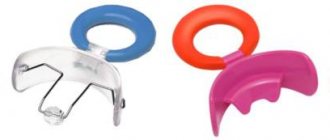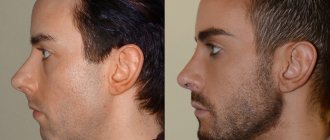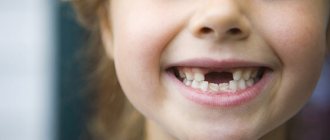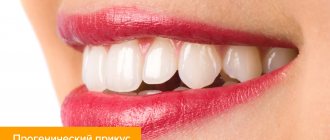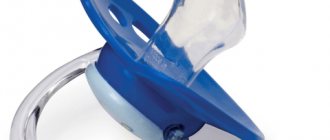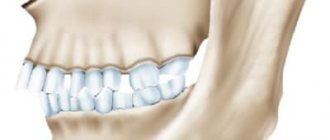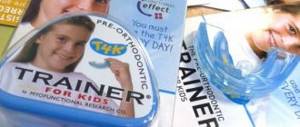Stages of bite formation in children
The process of developing a child’s bite can be divided into several important stages.
Each of them is characterized by changes in the structure of the jaw and has factors that influence the formation of pathology. Stages of bite development in children:
- Elementary.
From birth to six months of the child. The first teeth begin to erupt towards the end of the period. The cause of pathology at this stage is a genetic predisposition or improper latching of the nipple during breastfeeding. - The process of formation of the bite of primary teeth.
Lasts until the age of three; as a rule, by the end of the period, all 20 baby teeth are in their position. At this age, the presence of gaps between the teeth is acceptable, but twisting, too close a fit, and growth in an uncharacteristic plane are considered as deviations from the norm. In addition to the above reasons, the most common factor in the development of pathology is bad habits: thumb sucking, pacifiers, toys or eating disorders. The child's diet should include a sufficient amount of solid food. - Preparation for the development of permanent dentition.
The stage continues until the appearance of the first permanent teeth. With proper oral care, no external changes are observed during this period. Bad habits can cause malocclusion. It is necessary to ensure that the child does not chew hard objects: pencils, thick books, furniture, since baby teeth are very soft and easily deformed. - Changing the temporary bite to a permanent one.
The most critical stage. It is during this period that serious pathologies begin to manifest themselves as unpleasant changes: torsion, improper growth of teeth, discrepancy between the size of the jaw and the volume of bone units, etc. On average, this period lasts up to 12 years. Factors in the development of anomalies are physiological characteristics or untimely replacement of teeth. - Formation of a permanent bite.
The teeth complete their growth and occupy a certain position in the jaw.
You can start correcting your bite from the early stages. There are several hardware and manual methods for this. Treatment with braces begins after a permanent bite has formed.
Application of braces
These are permanent structures. Braces are attached to each tooth individually. The design includes ligatures, arches, springs and braces. These devices are installed at the age of 12. Then the baby has only permanent teeth in his mouth.
While wearing them, you often have to visit the orthodontist. He adjusts the tension using a wire. The little child will have to wear them around the clock. Therefore, it is important to convey to the little patient that he will have to do this. In addition, the child will have to change his favorite habits. For example, he is strictly forbidden to chew gum and eat solid (nuts) food.
Braces are:
- sapphire;
- metal;
- ceramic.
Sapphire systems, due to the material used, are not noticeable on the teeth. But they are only suitable for people with white enamel color. The design is not painted and does not retain plaque or food debris. The disadvantage is the time it takes to correct uneven teeth. It is larger than that of metal braces.
The metal version is the simplest, cheapest and very old. The entire structure is attached to the outside of the teeth. The positive feature of steel braces is their good strength, the disadvantage is their unaesthetic appearance.
The modern version of braces includes ceramic braces. They are aesthetic, relatively inexpensive and invisible.
Signs of malocclusion
For timely detection of maxillofacial defects, it is necessary to regularly examine the baby’s oral cavity. Here are a few signs by which you can identify a malocclusion in a child:
- obvious displacement of the lower jaw outward or inward;
- crooked, uneven teeth;
- vestibular or lingual growth of teeth - in front or behind the main row;
- diastema - spaces between the incisors;
- strong overlap of the lower teeth with the upper ones;
- non-closure of the upper and lower incisors with a formed bite;
- half-open mouth, replacement of nasal breathing;
- speech defects.
Signs of malocclusion
In addition to the visible signs, if you look closely, you can notice abrasion of the enamel on the front or back teeth, and gum injuries. The child complains of tension in the jaw muscles, difficulty chewing or swallowing food, and headache. These signs will help you understand that your child has a malocclusion and seek advice from an orthodontist.
Types of malocclusion
The curvature of the teeth does not always mean a pathology of the bite, which is understood as the closing of the jaws, ensuring the full, unhindered functioning of the masticatory apparatus.
Among the types of malocclusion in children are:
- Prognathia – distal occlusion.
This is a common reason for visiting an orthodontist in early childhood. The muscles of the lower jaw are not yet sufficiently developed, so outwardly it seems that the upper row of teeth protrudes strongly forward compared to the lower one. With the introduction of hard foods into the diet: hard fruits and vegetables, the problem may disappear without medical intervention. - Progenia – mesial occlusion.
At an early age, this pathology is usually caused by genetic characteristics or improper latching of the nipple during feeding. The sooner the pathology is identified and treatment is prescribed, the fewer negative consequences the child will receive. - Deep bite.
Parents often confuse it with the distal one, however, with a deep bite, the lower jaw does not go back, but seems to sink inside. The upper front incisors overlap the lower ones by more than half. Obvious signs of pathology are speech defects and soft tissue injuries. - Crossbite.
It appears at the stage of replacement of milk teeth with molars. In this case, on the one hand, the upper jaw overlaps the lower jaw, on the other, the lower teeth come to the fore. - Open bite.
With this malocclusion pathology, there is a noticeable lack of closure between the teeth of the upper and lower rows. Most often, this disorder affects the incisors, but it also occurs on the posterior premolars and molars.
Types of Malocclusions
Malocclusions in children are diagnosed during annual examinations. It is important not to waste time and immediately begin preventive or therapeutic treatment.
Consolidation of treatment results
The retention period is an important stage of treatment, necessary to consolidate and stabilize the results of treatment. A non-removable wire retainer is installed on the lower front teeth, and a removable mouthguard is installed on the upper jaw, which must be worn only at night. In this case, the patient needs to be observed not only by an orthodontist, but also by an osteopath and a neuromuscular dentist. Retention usually takes 2 times longer than orthodontic treatment (the exact timing is determined by the attending physician).
Photos of children with pathological bite
In the presented images you can see the child’s malocclusion. The photo shows various pathologies that are often found in patients with baby or molar teeth. Detailed photographs of children with malocclusion captured in the photo during an orthodontic consultation will help parents in self-diagnosis of the pathology. However, the doctor chooses the effective therapy regimen.
Photo of a girl with an incorrect open bite
Photo of a child with an incorrect deep bite
Photo of a boy with an incorrect deep distal bite
The boy has an open bite
The girl has a deep distal bite
Teeth straightening
Treatment with Damon-Q braces was aimed at straightening the teeth and normalizing the shape of the dentition.
Photo of the beginning of treatment with Damon-Q braces:
The duration of orthodontic treatment with braces was 8 months, the patient visited the orthodontist once every two months (4 visits in total). The final correction of the bite was carried out using orthodontic elastics. They are necessary to create precise interdental contacts. All this time, the patient continued to wear a fixed orthotic, which was removed at the very end of treatment.
How to correct a child's bite
No matter how severe the pathology, the earlier treatment is started, the easier it is to achieve an effective result. To correct violations, there are three ways to correct bite in children:
- traditional – installation of braces;
- alternative (without braces) – mouth guards, plates, physiotherapy;
- cardinal – surgical intervention.
Until the final stage of permanent bite formation, only alternative methods are used, but is it possible to correct a child’s malocclusion with their help?
Removable orthodontic plates
Orthodontic plates
are structures consisting of a polymer jaw-expanding base and metal arches that serve to fix the plate and align the front row of teeth.
Removable orthodontic plate
These devices are made individually, based on casts of the jaw of a small patient. To adjust the load, the devices are equipped with screws and expanders. At an appointment with a doctor, the child’s parents will learn how to perform this procedure on their own, which will save time on visits to the orthodontist.
Plates for correcting malocclusion in children are designed to be worn constantly, but the removable structures are removed during meals or hygiene procedures.
Trainers for teeth
Trainers
To correct malocclusion in children, they are mouth guards made of dense silicone.
Trainer for correcting the bite
The trainer performs several functions:
- Self-corrects minor pathologies.
- Prevents further development of malocclusion and prevents complications.
- Helps get rid of bad habits that have caused crooked teeth.
Mouth guards for correcting malocclusion in children fix both jaws simultaneously in the correct position. But when using them, it is impossible to lead a normal lifestyle: talking, eating. Therefore, mouthguards are worn while the child is sleeping and for several hours during the day.
The process of correcting a bite with trainers is long and requires patience from the child and parents.
It has been noticed that in children who regularly use trainers before installing braces, the effect of therapy occurs faster.
Myotherapy
Myogymnastics
in orthodontics, it is a set of exercises to relax or develop individual facial muscles.
Myotherapy in orthodontics
The method serves as both a primary and an auxiliary method of occlusion correction. For each type of pathology there is its own set of exercises. The first lessons are carried out under the supervision of an orthodontist; as soon as the child learns to do gymnastics correctly, he continues to work at home independently or with his parents.
Conditions for performing exercises to correct bite in children:
- Systematicity and regularity.
- Sufficient application of force without jerking or pressure. The muscles feel resistance, but are not overloaded.
- Cyclicality. Exercises are performed in several approaches to achieve good results.
- Gradual increase in load and intensity.
Myotherapy is especially effective in correcting occlusion in combination with physiotherapy: electrophoresis, vibration massage, ultrasound, vacuum therapy, massage.
Alternative methods can correct mild pathologies of malocclusion in early childhood or slow down the development of complications and wait until the formation of the jaw is completed to begin basic treatment.
Braces
Braces
– the main way to correct uneven teeth and malocclusion in children from 12–16 years old and adults of any age.
Braces for correcting bite
They are a system of clasps fixed on the outer or inner surface of the teeth and a steel arch stretched between them.
Under the pressure of the arch, the teeth are aligned and placed in the correct position. With the help of braces, it is possible to correct almost all malocclusion pathologies. Treatment takes from 6 to 18 months and ends with the acquisition of a beautiful, even smile.
Application of records
The design does not require constant wear and is a removable device. It is usually removed during meals or under other circumstances when the baby feels discomfort from it.
The design has several metal elements (screws, hooks, arcs and springs). It is made separately for each patient. The manufacturing procedure is as follows: an orthodontist examines, takes impressions of the jaw, a plaster model is cast in the laboratory based on the impressions, and a plate is made based on the resulting model. The orthodontist independently adjusts the position of the springs and hooks. Such actions by the doctor allow you to move the teeth and dentition in the right direction.
Plates effectively correct malocclusion in the early stages. But sometimes you can hear from friends that the above-described structures did not allow their children to correct their bite. It is not true. With constant wear and compliance with all the recommendations of the orthodontist, the desired result will definitely occur. Although the plates are not permanently installed devices, they must be worn without removing them. It is allowed to remove the structures only when eating, brushing your teeth and in some other life situations (for example, when taking photographs).
Some capricious children do not want to wear records. The task of parents is to convey to the child information about the need for treatment. At the same time, there is an urgent need for constant monitoring of the child. You will need to monitor whether the child has removed the device.
Treatment of malocclusion in children of different ages
Anomalies in jaw development and tooth growth cannot be ignored. Early childhood is not a reason to refuse correction. The orthodontist will help you choose the most effective treatment method. The use of alternative therapy methods can completely restore jaw function or prevent the occurrence of health-threatening complications.
Let's look at how malocclusion is treated in children of different ages.
Children under one year old
At this age, parents' actions should be aimed at preventing the development of jaw pathologies. Effective measures include:
- maintaining the correct position of the head during feeding, it does not tilt back, the chin is not pressed against the baby’s chest, make sure that the nipple is grasped correctly;
- the use of orthodontic pacifiers that imitate the female nipple and promote the correct position of the jaws when sucking;
- preventing the development of bad habits;
- introduction of solid food into the diet with the appearance of the first teeth;
- adequate consumption by mother and child of foods containing fluoride and calcium or vitamin supplements designed specifically for nursing women;
- preventive examination at the dentist.
Most often, malocclusion in a child of the first year of life develops due to the use of a low-quality pacifier, so the choice of this accessory is very important.
Children from 1 to 2 years old
There are often questions from worried parents on the Internet: “My child is one year old, it seems that he has the wrong bite, what should I do?” First of all, if you suspect the development of pathology, you need to show the baby to a specialist. He will determine whether the feature is an age-related norm or a complication.
Malocclusion in a 1-year-old child occurs as a result of dysfunction of sucking (and then chewing). At such an early age, hardware correction methods are not yet available, so physiotherapy and the use of orthodontic pacifiers, which return the jaw to its normal position, are most often prescribed.
To correct malocclusion in a child 2 years of age and older, Hintz plates are used, which are similar in shape to a pacifier, but instead of a pacifier, a flap is placed in the mouth and clamped between the teeth. The longer the device is used, the faster the bite is corrected and bad habits are eliminated.
Children from 3 to 5 years old
Malocclusion in a 3-year-old child is corrected with special caps for correcting the position of the jaw, which are worn at night. You can also continue therapy using Hintz plates.
Another accessible method at this age is myogymnastics. A three-year-old child can easily cope with the exercises.
From 4 years of age it is allowed to use LM activators under the supervision of an orthodontist. And malocclusion in a 5-year-old child is corrected with the help of trainers and orthodontic plates.
The first thing to do when malocclusion is detected is to show the child to a qualified orthodontist.
Children from 6 to 14 years old
Malocclusion in a 6-year-old child should cause the greatest concern for parents, since when baby teeth are replaced, this pathology will certainly affect the growth of permanent bone units.
Therefore, careful adherence to the dentist's recommendations is necessary. At this age, all alternative methods are available; the doctor will select the most effective one.
Care
Parents should show their child how to properly care for installed devices. Poor hygiene will greatly increase the risk of dental caries. Maintenance consists of regular cleaning. It is advisable to have a separate brush for plates and trays. In addition to it, you can use pastes and gels sold through the pharmacy chain.
Special attention must be paid to braces systems. Due to the fact that it is not removable, a large amount of food gets stuck in the structure. Therefore, it needs to be cleaned after each use. Threads and brushes will be used to help the patient.
Parents either must teach the baby to perform care procedures correctly or take on the entire process themselves. Here control from the older generation is necessary.
Causes of malocclusion
Many factors influence jaw development. Among the main reasons for the formation of malocclusion in children are:
- heredity;
- incorrect position during breastfeeding, incorrect grip of the nipple or bottle nipple;
- bad habits;
- physiological features, for example, a narrow jaw;
- late transition to solid food;
- ENT diseases;
- metabolic disorders, lack of microelements;
- incorrect posture;
- intrauterine developmental pathologies;
- early loss of baby teeth or delayed loss of teeth;
- accompanying illnesses.
The habit of thumb sucking can cause malocclusion.
Before starting treatment, you need to make sure that the factor that caused the pathology no longer has an effect.
Correcting a child’s malocclusion without eliminating the cause is ineffective.
Exercises to correct your bite
After identifying malocclusion in children, the doctor may prescribe myogymnastics. The therapy is aimed at restoring muscle motor activity, training the tongue and lips. To correct a child’s bite, it is necessary to achieve myodynamic balance: the strength of the muscles outside and inside the oral cavity must be equal. The development of facial and dental pathologies can provoke weakening of muscle tissue.
A set of therapeutic exercises:
- Massage your lower and upper lips with your index finger for 3-5 minutes. The exercise must be repeated several times a day.
- Connect 2 large buttons with a cord. The child must hold one of them with his teeth, and the second he must pick up and stretch the lace. Do 10 approaches.
- Pull out your lips with a tube. Forcefully inhale and exhale air through your mouth. Repeat the exercise several times.
- Purse your lips tightly and draw air into your mouth. Press your fingers on the swollen cheeks, do 5-7 approaches.
- The lips, stretched out like a tube, should be compressed and unclenched with force. Perform the exercise for 2-3 minutes.
- Move the lower jaw forward as much as possible, and try to reach the upper lip with your teeth. Fix the position for 2-3 minutes.
- Place a plastic ruler between your lips and press on the opposite edge with your finger.
- Hold the plastic card between your lips and hold the position for a few minutes.
Tongue exercises are best done after gymnastics. These include:
- counting teeth from the inside;
- stroking the soft and hard palate with the tongue;
- clicking.
If a child has one or more teeth growing incorrectly, they can be gently pressed with the tip of the tongue from the inside for 2-3 minutes. To strengthen the cheek muscles, the child should take water into his mouth and hold it for several minutes, then spit it out. To practice breathing, experts recommend alternately pinching first the left, then the right nostril.
The technique has age restrictions. Treatment can begin at 3 years of age. Playing the trumpet and other wind instruments and blowing soap bubbles through a plastic tube or straw will help train your muscles.
Consequences
What complications can arise if a child’s malocclusion is not corrected? Possible consequences:
- tooth abrasion, premature wear, increased risk of caries;
- difficulty chewing causes gastrointestinal problems;
- mucosal injuries, gum inflammation, periodontal disease;
- increased load on the temporomandibular joint, pain, inflammation;
- breathing problems, ENT diseases;
- pinched nerves in the cervical spine;
- aesthetic facial defects, asymmetry;
- psychological problems;
- violation of diction.
Thus, malocclusion in children is dangerous for the development of diseases. It directly affects the emotional state of the individual, self-esteem, and self-confidence. If the bite is not corrected in time, physiological, psychological and aesthetic problems may develop.
Prevention
Prevention of the development of malocclusion in children begins at an early age. By following simple recommendations, you can avoid problems and maintain your baby’s beautiful smile.
Dentists' advice:
- Correct attachment to the breast or bottle. Usually a new mother will be helped with this by a pediatric nurse or a breastfeeding specialist.
- Prevent the development of bad habits, gradually abandon the pacifier when the first teeth appear.
- Supplement your diet with solid food in a timely manner.
- Keep your mouth clean.
- Perform gymnastics to develop facial muscles.
The effectiveness of preventive measures can be monitored by a local dentist, whose consultation is recommended for children at least once a year.
The health of a child’s teeth affects not only the appearance, but also the functioning of the entire body. Incorrect bite is the cause of serious illnesses. Therefore, it is important to identify pathologies in time and correct them using methods available for a given age.
How to warn?
If a child has a malocclusion at the genetic level, then, unfortunately, this fact cannot be prevented. But other factors can be significantly minimized. To do this, read the following tips:
- The rudiments of teeth are formed in the fetus at 20 weeks. Therefore, the expectant mother is obliged to eat foods with fluoride and calcium.
- Artificial feeding has a bad effect on the bite. The upper jaw of newborns is larger than the opposite one. Their sizes eventually come to the same value due to breastfeeding. At this time, the facial muscles are actively trained. When your baby feeds from a bottle, the hole in the nipple is larger than the “hole” in the breast. It turns out that the child does not suck, but drinks milk in sips.
- Always pay attention to your child's breathing. It should be through the nose. Be sure to consult a specialist if you notice any irregularities.
- When your baby's first teeth begin to appear, wean him off the pacifier or your finger (if he takes it). The risk of malocclusion increases.
- Visit the dentist even for no apparent reason (2 times a year).
In conclusion, we remind you that for a small child the time needed to correct the bite will be less than for older children.
Sources used:
- https://www.dentsplysirona.com
- Feres MF, Abreu LG, Insabralde NM, Almeida MR, Flores-Mir C (June 2016). “Effectiveness of the open bite treatment in growing children and adolescents. A systematic review". European Journal of Orthodontics.
- Fishchev, S.B. Emergencies in dentistry and maxillofacial surgery.
